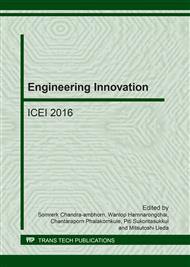[1]
M.F. Demirbas, M. Balat, H. Balat, Biowaste-to-biofuels, Energ Convers Manage. 52 (2011) 1815–1828.
DOI: 10.1016/j.enconman.2010.10.041
Google Scholar
[2]
H.L. Wang, J.F. Calvins, Yield and amino acid composition of fractions obtained during tofu production, Cereal Chem. 66 (1989) 359–361.
Google Scholar
[3]
Y. Puechkamut, W. Panyathitipong, Characteristics of proteins from fresh and dried residues of soy milk production, Kasetsart J. Nat Sci. 46 (2012) 804–811.
Google Scholar
[4]
T. Kudra, A.S. Mujumdar, Advanced Drying Technologies, Marcel Dekker, New York, (2002).
Google Scholar
[5]
T. Kudra, A.S. Mujumdar, Handbook of Industrial Drying, third ed, Marcel Dekker, New York, (2007).
Google Scholar
[6]
I.T. Elperin, Heat and mass transfer in opposing currents, J Eng Phys Thermophys. 4 (1961) 62–68.
Google Scholar
[7]
A. Tamir, Impinging-Stream Reactors: Fundamentals and Applications, Elsevier Science, Amsterdam, (1994).
Google Scholar
[8]
A. Tamir, I. Elperin, K. Luzzatto, Drying in a new two impinging streams reactor, Chem Eng Sci. 39 (1984) 139–146.
DOI: 10.1016/0009-2509(84)80139-6
Google Scholar
[9]
A. Kitron, R. Buchmann, K. Luzzatto, A. Tamir, Drying and mixing of solids and particles residence time distribution in four impinging streams and multistage two impinging streams reactor, Ind Eng Chem Res. 26 (1987) 2454–2461.
DOI: 10.1021/ie00072a012
Google Scholar
[10]
Y. Kitron, A. Tamir, Performance of a coaxial gas-solid two-impinging-streams (TIS) reactor: Hydrodynamics, residence time distribution, and drying heat transfer, Ind Eng Chem Res. 27 (1988) 1760–1767.
DOI: 10.1021/ie00082a005
Google Scholar
[11]
X. Hu, D. Liu, Experimental investigation on flow and drying characteristics of a vertical and semi-cyclic combined impinging streams dryer, Drying Technol. 17 (1999) 1879–1892.
DOI: 10.1080/07373939908917658
Google Scholar
[12]
K. Sathapornprasath, S. Devahastin, S. Soponronnarit, Performance evaluation of an impinging stream dryer for particulate materials, Drying Technol. 25 (2007) 1111–1118.
DOI: 10.1080/07373930701397251
Google Scholar
[13]
K. Choicharoen, S. Devahastin, S. Soponronnarit, Performance and energy consumption of an impinging stream dryer for high-moisture particulate materials, Drying Technol. 28 (2010), 20–29.
DOI: 10.1080/07373930903423608
Google Scholar
[14]
K. Choicharoen, S. Devahastin, S. Soponronnarit, Comparative evaluation of performance and energy consumption of hot air and superheated steam impinging stream dryers for high-moisture particulate materials, Appl Therm Eng 31 (2011) 3444–3452.
DOI: 10.1016/j.applthermaleng.2011.06.030
Google Scholar
[15]
AOAC, Official Methods of Analysis, sixteenth ed., Association of Official Agricultural Chemists, Washington DC, (1995).
Google Scholar
[16]
S. Wachiraphansakul, S. Devahastin, Drying kinetics and quality of soy residue (okara) dried in a jet spouted bed dryer, Drying Technol. 23 (2005) 1229–1242.
DOI: 10.1081/drt-200059421
Google Scholar
[17]
M.K. Krokida, Z.B. Maroulis, G.D. Saravacos, The effect of the method of drying on the colour of dehydrated products, Int J Food Sci Technol. 36 (2001) 53–59.
DOI: 10.1046/j.1365-2621.2001.00426.x
Google Scholar


